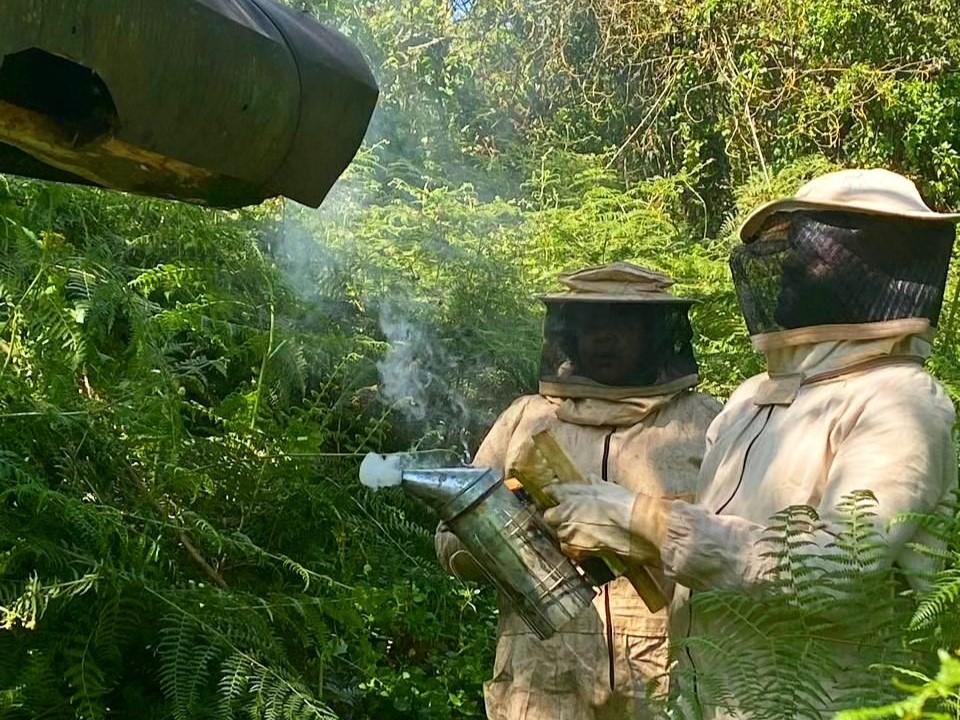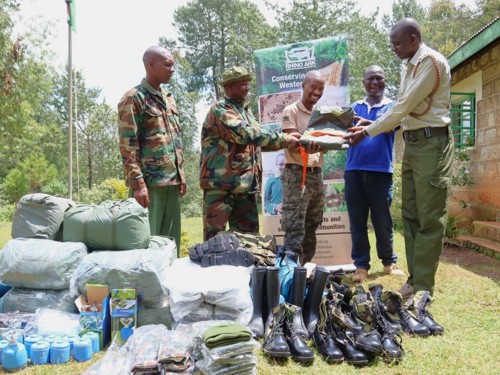Growing forests with private finance

Beekeeping training. Credit - Zach Okoth, Rhino Ark.
Transforming communities and conserving ecosystems in Kenya’s mountain forests
Kenya’s mountain forests are among the country’s most precious natural assets. They are critical ‘water towers’, feeding rivers such as the Sondu, Mara, and Malewa, and they are home to endangered species like the Mountain bongo, elephant, leopard, and Black rhino. They also provide resources that sustain millions of people. Yet for decades, forests such as the Aberdares and the South Western Mau were in crisis, ravaged by illegal logging, charcoal production, grazing, and poaching. Communities living along their edges, often among the poorest, had few alternatives to such activities and were torn between survival and stewardship.
In 2022, Rhino Ark and its partners launched a project to restore degraded forests, reduce illegal activities, and provide conservation-compatible livelihoods. Over two and a half years, the project has not only rehabilitated landscapes but also transformed lives. At the start of the project, parts of South Western Mau and the Aberdares were severely degraded. Canopy loss, eroded soils, and dried springs threatened both wildlife and downstream communities. Working with Community Forest Associations (CFAs), the project set out to restore 80 ha of forest. By March 2025, it had exceeded this goal, restoring 95 ha. More than 1,800 men and women earned wages through site preparation, planting, and maintenance, with micro-fencing used to protect seedlings. Over 80,000 indigenous trees, including Olea africana and Dombeya torrida, were planted, achieving survival rates above 70%.
The ecological benefits became visible. In some areas, natural springs that had long dried up began to flow again. One woman, Jane Njeri, who previously walked kilometres uphill carrying water on her back, now finds clean water just behind her home. These ‘unexpected outcomes’ reinforced the link between restoration and human wellbeing.
 The community help restore the South Western Mau. Credit - Zach Okoth, Rhino Ark.
The community help restore the South Western Mau. Credit - Zach Okoth, Rhino Ark.
 Rehabilitation in Aberdares. Credit - Zach Okoth, Rhino Ark.
Rehabilitation in Aberdares. Credit - Zach Okoth, Rhino Ark.In South Western Mau, beekeeping emerged as a powerful livelihood alternative. A census revealed 1,900 hives, most of them traditional and low-yielding. Through training by the National Beekeeping Institute, 50 farmers received modern hives and advanced skills. Exchange visits to cooperatives, such as Kapkuikui in Baringo, opened eyes to what was possible. Out of this grew the Ndoinet Honey Cooperative, now formally registered and operating with over 100 members. With shared processing equipment and collective marketing, the cooperative produces more than 200 kg of honey every month. Income has risen by as much as 60% for some households, and women are increasingly stepping in as lead beekeepers.
As one beekeeper, Joseah Mutai, explained: “Before, I sold honey in tins at the roadside. Now, with modern hives and our cooperative, I package and sell to bigger markets. My children’s school fees are no longer a struggle.”
In the Aberdares, the project tapped into ecotourism potential that had remained unrealised. Twenty-nine community members, some of whom had depended on charcoal burning, were trained and certified as guides, porters, and cooks. Together with the Kenya Forest Service, they helped open 56.5 km of trails, linking Table Mountain, Seven Ponds, and the summit of Ol Donyo Lesatima. For visitors, these trails reveal breathtaking scenery; for the guides, they represent dignity and opportunity.
Moses Njoroge, Table Mountain Guide, put it simply: “Charcoal gave me quick money but destroyed the forest. Now I earn more as a guide, and I protect what tourists come to see.”
Early bookings have already begun, supported by media features showcasing the new routes. The model has sparked interest from neighbouring communities eager to replicate it.
 Ecotourism signages mapped in Aberdares. Credit - Zach Okoth, Rhino Ark.
Ecotourism signages mapped in Aberdares. Credit - Zach Okoth, Rhino Ark.
Forest restoration and livelihoods alone would not be enough if illegal activities continued unchecked. In South Western Mau, enforcement had long been weak, with over 1,700 livestock intrusions, 160 cases of logging, and 91 charcoal kilns recorded in 2022. To change this, the project invested in infrastructure and people. Two new ranger outposts were built in Bosta and Korabariet, providing year-round monitoring. Meanwhile, a Joint Surveillance Unit (JSU) was formed, comprising eight trained community rangers (including two women), reinforcing the Kenya Forest Service. The JSU has been so effective that, with new funding, Rhino Ark is now establishing a second JSU.
Many JSU recruits were once involved in the very activities they now fight against. One ranger, George Yegon, shared: “I used to think the forest was endless. Logging was my way of survival. But now I patrol to protect it. I have seen how fast the trees can disappear and how they can restore if we care for them.”
Results were swift. Charcoal kilns dropped from 91 in 2022 to just 2 by early 2025. Illegal logging cases fell from 160 to 4. Livestock incursions reduced by almost 90%. In the Aberdares, the project also completed 12 km of fencing, bringing the electric fence to 410 km — the longest conservation fence in Africa. This barrier has not only curbed illegal exploitation but also reduced human-wildlife conflict, saving crops and lives.
Behind these successes lies stronger community governance. Both Geta and Ndoinet CFAs were revitalised, with membership surging to over 3,900 individuals, up from 800 just a few years ago. New constitutions, inclusive elections, and photo-based membership cards have given these associations renewed legitimacy. Women and youth now sit on committees, manage nurseries, and lead enterprises.
“Before, decisions were made by a few elders. Now, women and youth are part of the leadership. Conservation has become everyone’s responsibility.”
As one young CFA leader in Ndoinet noted: “Before, decisions were made by a few elders. Now, women and youth are part of the leadership. Conservation has become everyone’s responsibility.”
By March 2025, the numbers told a compelling story: 95 ha of forest restored; more than 40,000 seedlings produced annually; over 200 kg of honey harvested monthly; 29 ecotourism service providers certified; 8 rangers trained and deployed; charcoal kilns reduced by 98%, illegal logging cut by 97%, and livestock intrusions down by 89%; and 3,900 CFA members, including women, youth, and persons with disabilities, engaged in co-management.
These achievements were underpinned by additional funding and partnerships. Rhino Ark secured co-financing from the Platcorp Foundation to expand restoration in Mau, effectively pairing Darwin Initiative funds with private sector contributions. Nevertheless, challenges remained. The two and a half year timeframe was short relative to the scale of ecological recovery required. Yet Rhino Ark and its partners worked relentlessly, adapting management approaches and fostering strong community ownership.
Written by Gloria Waswa. For more information on this Darwin Initiative Main project 29-031, led by Rhino Ark Kenya Charitable Trust, please click here.
 Askari equipment. Credit - Zach Okoth, Rhino Ark.
Askari equipment. Credit - Zach Okoth, Rhino Ark.
 A Joint Surveillance Unit demolish illegal makeshift in Mau. Credit - Zach Okoth, Rhino Ark.
A Joint Surveillance Unit demolish illegal makeshift in Mau. Credit - Zach Okoth, Rhino Ark.
 Describing the 10 km Conservation project 2. Credit - Zach Okoth, Rhino Ark.
Describing the 10 km Conservation project 2. Credit - Zach Okoth, Rhino Ark.
 12 km Conservation fence progress in Aberdares. Credit - Zach Okoth, Rhino Ark.
12 km Conservation fence progress in Aberdares. Credit - Zach Okoth, Rhino Ark.

 Back
Back